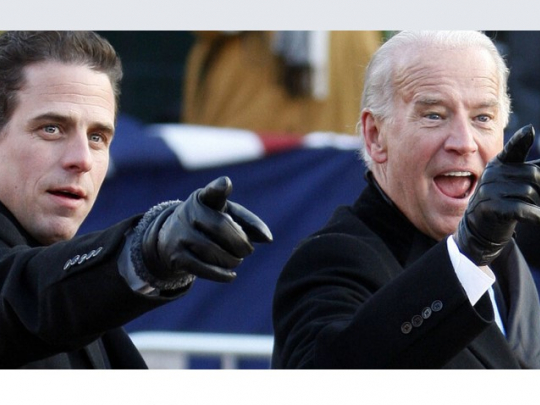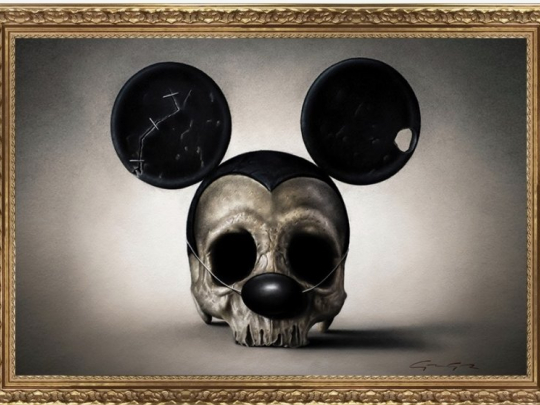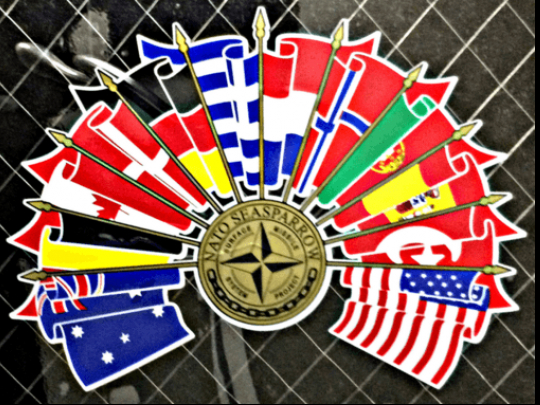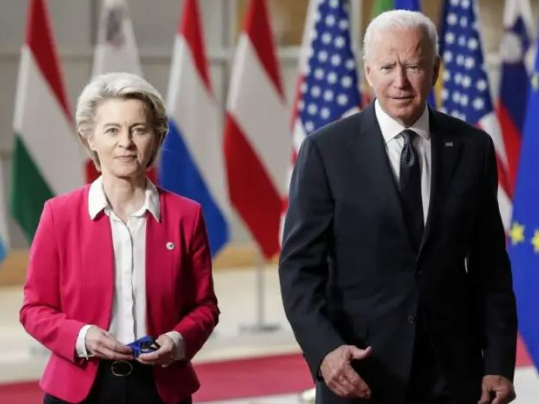How the Pentagon Leaned on Hollywood to Sell the War in Afghanistan
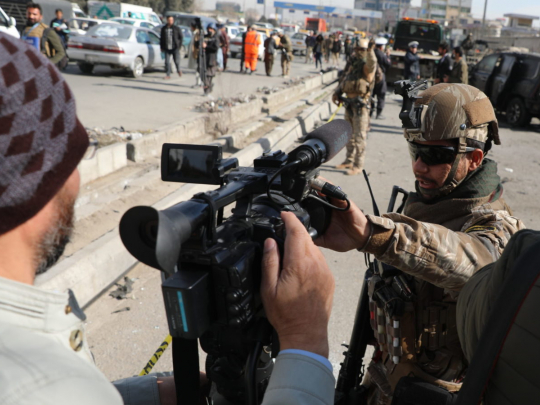
The (official) 20-year U.S. occupation of Afghanistan has come to a close, with the military beating a hasty and ignominious retreat. The puppet Afghan government NATO installed lasted fewer than two weeks on its own, with President Ashraf Ghani fleeing for the UAE, allegedly with around $169 million in cash.
If the occupation was so unpopular and weak, how was it able to last so long? The Afghanistan Papers — a trove of military documents leaked to The Washington Post — showed that high-ranking government officials knew that the war was unwinnable but were openly lying to the public about how it was going, all while NGOs and military contractors made billions.
But documents obtained by journalist Tom Secker under the Freedom of Information Act and shared with MintPress also show that Hollywood also played a significant role, knowingly collaborating with the Pentagon to produce pro-war propaganda about Afghanistan, ultimately helping to artificially buoy public opinion on the unwinnable campaign. This typically included giving the Pentagon direct editorial control over scripts and even removing any anti-war content or scenes that would show the military in a negative light. In exchange, the military offered its human resources, its bases as locations for filming, and its wide range of hi-tech vehicles to be used in movies. This quid pro quo effectively turned much of Hollywood, and the entertainment industry more generally, into cheerleaders for imperialism.
The military-industrial-media complex
Reading through the documents, what becomes clear is the sheer scale of the military’s involvement in the silver screen, and in pop culture more generally. For instance, between 2015 and 2017, the U.S. Army’s Office of the Chief of Public Affairs West (OCPA-W) — based just outside of Hollywood, CA — was generally working on between 40 and 70 entertainment media projects at one time. The OCPA-W is one of three Army regional offices, the others being in Chicago and New York City. The Navy, Air Force, Coast Guard, CIA and other government organizations all have similar agencies and programs aimed at manipulating their image in mass media.
The OCPA-W’s weekly summary of its affairs for the week of December 22, 2016, for example, notes that it is involved in 63 working projects; 15 in pre-production, 26 in production and 22 in post-production. According to research by Secker and Matthew Alford for their 2017 book “National Security Cinema,” the Department of Defense has supported at least 814 movies and 1,133 separate TV shows, the majority of those in recent years.
Afghanistan is generally far from American minds. This is by design: few at the top of American society want the public to be scrutinizing U.S. actions there. When the country is portrayed on American screens, the military works extremely hard to present the war in a way most conducive to its interests. Hollywood has been a willing collaborator in this. Below is a selection of case studies of movies about or featuring the war in Afghanistan and a discussion about how the U.S. military has had those movies sanitized before they ever met the public eye.
12 Strong (2018)
“12 Strong” is a jingoistic action film based on a true story about a small unit of 12 U.S. Special Forces who invaded Afghanistan immediately after the September 11 attacks, thus being the first American boots on the ground of a two-decade campaign that cost the lives of an estimated 176,000 Afghans, displacing almost 6 million more.
The film entails the elite group attempting to capture the city of Mazar-i-Sharif before NATO forces arrive. The team, so they say, is outnumbered by “50,000 Taliban and Al-Qaeda forces,” as if the two were close allies. This is despite the fact that the Taliban immediately condemned the 9/11 attacks and that Western estimates put al-Qaeda’s global forces at the time at below 100 members. “If we don’t take that city, the World Trade Center is just the beginning,” says one of the heroes of the film, whose tagline is “twelve soldiers gave us a reason to hope.”
Documents show that the military was eager to help with such a nationalistic film, and matched what they called the production company’s “breathtaking” list of asks, including access to a number of military bases in New Mexico for shooting; army uniforms for actors; “target” vehicles they could blow up; the hire of a number of aircraft, including Chinook and Seahawk helicopters; and appropriate Soviet tanks for the enemy to use. They also aided the company in finding military extras to appear in minor roles.
Despite the movie’s strongly pro-war message, the OCPA-W, Air Force, and other military organizations still insisted on going through the script with a fine-toothed comb, removing even minor details it did not like. This included demanding that writers changed their plans to present the 12 soldiers as rugged men with full beards and tattoos. An email from OCPA read:
My other concern is that during the loadout sequences at Fort Campbell that occurred shortly after 9/11 our soldiers did not have full length beards and neck tattoos. That came later. I hope [REDACTED] guys are going to Shave for those sequences.
A few weeks later, the seemingly minor point had not been resolved. In a show of just how much control over creative direction the military had, the OCPA threatened to pull out of the movie, reminding the production company of the agreement they had signed up for:
The production company agrees to cast actors, extras, doubles, and stunt personnel portraying military men and women who conform to individual Military Service regulations governing age, height / weight, uniform, grooming, appearance, and conduct standards. DoD reserves the right to suspend support in the event that disagreement regarding the military aspects of their portrayals cannot be resolved in negotiation between the production company and DoD within the seventy-two hour cure-period. The DoD Project Officer will provide written guidance specific to each Military Service being portrayed.
- U.S. Army.
(1) The depiction of Soldiers in the Continental United States prior to the September 11, 2001 terrorist attacks should be in accordance with U.S. Army Regulation 670-1, West and Appearance of Army Uniforms and Insignia. Soldiers would meet height/weight standards, be clean shaven, with a well-groomed haircut and be wearing the Battle Dress Uniform (BDU). Load bearing equipment would be olive drab or the BDU pattern.
(2) The depiction of deployed Soldiers following the September 11, 2001 terrorist attacks would be in accordance with the tactical situation. Soldiers would still meet height/weight requirements (appear physically fit) with relaxed grooming standards for extended operations. The deployed Soldiers would be wearing the Desert Combat Dress Uniform (DCU) with olive drab or BDU pattern load bearing equipment.
The Department of Defense is well aware that the sort of assistance they offer (free equipment, filming locations, etc.) would be enormously expensive, if not impossible, to otherwise obtain. Therefore, they leverage their considerable influence into what amounts to control over every aspect of a movie or TV show they work on. This often even means jettisoning reality in favor of a relentlessly pro-war message.
Emails show that OCPA instructed the production company to change the minor criminal backstory of one of the 12 soldiers, despite the fact it was perfectly real. As one OCPA official wrote:
I told him our two biggest issues were the background story of Cpt [REDACTED]
being any FNG [“Fucking New Guy,” a derogatory military term for recruits] when he was actually a Team Leader for two years and the comment about Sergeant [REDACTED] having a choice between Jail and the Army.
According to the book the bar fight incident did happen, [REDACTED] attorney
was able to plea deal it down to a misdemeanor with a probation period. He
did lose his job as a school teacher and he started to work construction. I [sic]
period of time later, he decided to join the US Army.
Production quickly agreed to the changes, a few weeks later sending a new script for the OCPA and Air Force’s approval. “Here is a revised draft of Horse Soldiers,” they replied. “We changed [REDACTED]’s backstory per your suggestion. Please let me know if this works for you. [PERSON’s NAME REDACTED], would you send this draft to the appropriate Air Force personnel and let me know whom to follow up with?” (Cross referencing the documents with the book it is based on makes it clear that the sergeant in question is Sam Diller, one of the main characters in both book and movie).
None of the military’s demands appear to have caused much resistance from the company. Indeed, towards the end of filming, a senior member of the team even emailed the OCPA and the Office of the Secretary of Defense to offer his profound gratitude for their services:
[The] Army and the entire team have been absolutely fantastic and helped us achieve an amazing air-to-air shoot this evening. They are the utmost professional highly trained crew. We know if it wasn’t for your great efforts to make this movie badass we would have never gotten such a team. We promise to make the Army proud, so THANK YOU!!!!!
The movie “12 Strong” depicts the #USArmy #soldiers who took down the Taliban after 9/11. #DoD assets helped create the movie. Here's some key facts about it.https://t.co/FInpxqO28E#12StrongMovie #KnowYourMil pic.twitter.com/7BxsN53s5c
— Department of Defense ???????? (@DeptofDefense) January 18, 2018
Lone Survivor (2013)
“Lone Survivor” is the largely true story of a Navy SEAL team that was discovered and attacked by the Taliban while carrying out a special operation to assassinate the organization’s commander, Ahmad Shah. The SEALs suffered devastating losses, leaving only one man — Marcus Luttrell — to tell the story.
The plot of the film revolves around the squad being discovered by local goat herders and their supposedly heart-wrenching decision on whether to kill the shepherds to cover their tracks, or let them go, the assumption being that the old man and two children in question would immediately alert the Taliban to their whereabouts. The group decided to let their captives go, which almost immediately turned out to be a deadly mistake.
The story is based upon the book by Luttrell, who is now a Trump-loving media anchor on Glenn Beck’s conservative TV network “TheBlaze.” At times, Luttrell’s book reads like the manifesto of a white-nationalist mass-shooter, and is peppered throughout with his seething hatred of liberals. Luttrell is extremely regretful that he went along with the decision to let the Afghans go and did not stick to his gut feeling and insist they murder an old man and two children (all unarmed). “It was the stupidest, most southern-fried, lamebrained decision I ever made in my life,” he wrote. “I’d turned into a fucking liberal, a half-assed, no-logic nitwit, all heart, no brain.” By way of explanation, he said that it was his certainty that the liberal media would betray the troops and side with the Taliban that made him release them, telling his fellow SEALs at the time:
Just so you all understand, their bodies will be found, the Taliban will use it to the max. They’ll get it in the papers, and the U.S. liberal media will attack us without mercy. We will almost certainly be charged with murder.
Apologizing for not carrying out what amounts to a war crime, he writes:
That situation might look simple in Washington, where the human rights of terrorists are often given high priority. And I am certain liberal politicians would defend their position to the death. Because everyone knows liberals have never been wrong about anything. You can ask them. Anytime.
The book is a glorification of supposedly righteous violence against a subhuman opponent. As he explains:
“In the global war on terror, we have rules, and our opponents use them against us. We try to be reasonable; they will stop at nothing. They will stoop to any form of base warfare: torture, beheading, mutilation. Attacks on innocent civilians, women and children, car bombs, suicide bombers, anything the hell they can think of. They’re right up there with the monsters of history.
The original script stayed close to Luttrell’s interpretation of events. Needless to say, however, the military demanded major rewrites. In the finished version, the Navy SEAL commander simply decides to let the goat herders go, with no arguments about whether to kill them and hide their bodies and certainly no long soliloquies about the treachery of the liberal media, as happens in the book.
The military often claims that they aid the film industry merely to ensure depictions of themselves are more accurate. Yet reading through 131 pages of declassified emails between them and production company, Film 44, it is clear that this is not the case. Indeed, Philip Strub, the Department of Defense’s chief Hollywood liaison, made this explicit, writing in a now-declassified email:
While maximizing historical authenticity is our mandate, we share responsibility for the reputations of the four SEALs and to their families’ memories of them.
What also becomes apparent after reading the documents is the level of intimacy between the movie industry and the military, and the latter’s fastidious attention to detail, poring over every single word of dialogue to ensure each frame is as pro-war as the film can get. Strub and his associates even insisted minor touches, like visible tattoos on the SEALs, be written out of the script. They also demanded the deletion of a scene in which Luttrell and another SEAL have a conversation about Power Bars, taunting each other, with Luttrell shouting “blow me, fag,” then loudly farting. This was presumably in an effort to ensure members of the Navy SEALs did not come across as uncouth as Lutrell does in his own book.
“I just learned from Film 44 (Sarah and Braden) that they are ready to submit Pete’s latest rewrite to us. They say that they have used our notes as a kind of check-list, and addressed all of our concerns. You’ll be receiving the watermarked script via email very shortly,” Strub wrote in an email that suggests that every draft script needed to meet the military’s exacting standards. Strub is one of the most powerful men in the entertainment industry. The list of movies and TV shows for which he is (publicly) credited is staggering, surely more impressive than virtually any other director or producer in Hollywood. Yet his name is all but unknown to the public.
The DoD’s chief Hollywood liaison, Phillip Strub, has had a hand in many of Hollywood’s biggest blockbusters
According to the documents, the military categorized their role in the movie into four parts: “script review and vetting,” “production department consulting,” talent training” and “on-set coaching.” In exchange for what amounts to total content control, the military provided “Lone Survivor’s” producers with the use of Kirtland Air Force Base in a rocky and sandy part of New Mexico that could easily pass for Afghanistan; the use of a multitude of expensive aircraft, including Black Hawk and Apache helicopters; and parachute jumpers and other general military personnel.
One reason for this continued involvement is obvious, and made explicit in the emails. “One of the criteria for DoD to support the movie is recruiting,” wrote an officer from U.S. Special Operations Command.
What is particularly noteworthy about this movie is that its entire premise — that if the SEALs chose not to kill the goat herders they would be found out — is demonstrably incorrect. Interviews with locals (including the man who hid and protected Luttrell, ensuring he was the lone survivor) establish that everybody in the area knew the SEALs were there, thanks to the elite unit’s own incompetence when it came to stealth. An enormous American helicopter landing in a remote part of rural Afghanistan was enough to raise suspicions among locals. If that was not enough, the SEAL team failed to dispose of evidence of their landing.
Unsurprisingly, Strub and his colleagues insisted this scene, which threatened to introduce a potential alternative reading of the movie — in which bungling Americans get caught, outmaneuvered, then slaughtered — was changed. This helped ensure the movie was as relentlessly pro-military as possible, despite the fact that it was telling the story of one of the deadliest U.S. military blunders of the entire war.
Charlie Wilson’s War (2007)
“Charlie Wilson’s War” tells the story of the eponymous Texas politician most famous for being the driving force behind Operation Cyclone — the CIA’s funding and training of the Afghan Mujahideen (an action that also turned the country into the world’s largest heroin producer).
The original script did not portray Wilson or his endeavors especially sympathetically, explicitly noting how he was supporting extremists like Osama Bin Laden’s al-Qaeda. One of these ultra-radicals was Gulbuddin Hekmatyar, a brutal warlord widely accused of starting the trend of throwing acid in women’s faces. Throughout the original script, 9/11 is presented as a foreseeable consequence of the U.S.’s decision to empower these violent fanatics. Indeed, the original end scene took place at the Pentagon on September 11, 2001, with Wilson hearing the deafening screech of an airliner hitting the building.
However, all this — al-Qaeda, Hekmatyar, and the 9/11 scene — was cut from the script after the CIA reviewed it. Instead, the finished film ends with Wilson receiving a medal for his services to freedom in Afghanistan. Also removed was a scene discussing the Sabra and Shatilla Massacres, where Israeli-backed forces slaughtered hundreds, if not thousands, of Palestinian refugees.
Earlier versions of the script also portrayed the Soviets somewhat sympathetically, with one character noting that Soviet atrocities in Afghanistan included “forc[ing] them [Afghans] to learn to read and write.” This was also cut in favor of portraying Soviet soldiers as brutal and unthinking monsters slaughtering the local population.
Geopolitics, Profit, and Poppies: How the CIA Turned Afghanistan into a Failed Narco-State
Whiskey Tango Foxtrot (2016)
The comedy-drama — which stars Tina Fey, Margot Robbie and Martin Freeman as Western journalists covering the Afghan War — was something of a flop at the box office. Still, it managed to reduce losses significantly by filming at Kirtland Air Force Base in New Mexico (just as “Lone Survivor” did) and using real U.S. Marines as extras. In exchange, producers handed over significant editorial control of the story to the military, which insisted on changing a scene where a U.S. military truck crashed into a crowd of civilians. In the final movie, there are no images of this, and the incident is referred to only in a 20-second news segment that describes it merely as “a fatal traffic accident involving a coalition truck.”
The crash was a real incident. In 2006, the truck plowed through Kabul during rush hour, killing at least three civilians and injuring many others. “Whiskey Tango Foxtrot” is based on American journalist Kim Barker’s memoir “The Taliban Shuffle.” The incident plays a major role in her book as the point where she finally understood how pointless and unwinnable the war was, how there was no accountability for the rich and powerful and no justice for the “have nots.” She described it and the following anti-U.S. riots as “a major breaking point in Afghanistan, the time when we first saw just how angry some Afghans were, just how ripe the country was for a Taliban comeback, just how leaderless Afghanistan really was.” Yet in the movie, the crash is mentioned only in passing, making the rioting Afghans appear irrationally angry and violent, a typical stereotype of Afghan War films.
Iron Man (2008)
The original “Iron Man” script was decidedly pacifist, with protagonist Tony Stark attempting to use his enormous manufacturing empire to battle against war profiteers and the military industrial complex. However, after the Pentagon got involved, with Philip Strub again acting as the military liaison, the tone of the movie was radically altered. Much of the fighting in the movie takes place in modern-day Afghanistan, with the U.S. military serving the role of the good guys. In this sense, the film’s stance on war was reversed.
In exchange, the production agreement notes that the military would allow the movie to be shot at Edwards Air Force Base, just north of Los Angeles; provide “approximately 150 extras at Edwards AFB to play military members from various services and Afghan nationals;” help produce around 100 uniforms; and provide the opportunity to use a range of expensive aircraft.
Tom Secker, when asked by MintPress to assess the U.S. film industry’s role in prolonging the Afghan war, responded:
Hollywood’s coverage of NATO’s war in Afghanistan has been notable by its absence, its silence, and its use of contextless microcosms which represent the war, rather than explore or explain it. “Iron Man” and “Lone Survivor” — two Pentagon-supported blockbusters — are both set during the U.S. occupation, but the scale of that occupation and the mess it was making of the country are ignored by both narratives, in favor of tightly-focused cinematic synecdoches which conveniently avoid the suffering of everyone involved.
Secker concluded:
In that sense, of course Hollywood has played a crucial role in perpetuating the war. They either failed to remind people that the war was still going on, or painted it in heroic, decontextualized colors that make it seem like a benevolent adventure halfway round the world, rather than the crushing, destructive geopolitical ratfuck it truly is.
A mediated war
It is not just big-budget Hollywood movies that the Pentagon works on, however. Practically every medium is used to spread a pro-war message. Declassified documents show that the Army flew Arnold Schwarzenegger to Afghanistan for the global-warming documentary TV series “Years of Living Dangerously.” This was, laughably, an effort to present the U.S. military — the single largest polluter in the world — as a force for good with regard to climate change, showing the former bodybuilder their supposed efforts to set up renewable energy systems across the Middle East.
Likewise, pop culture is full of strategically inserted pro-war messages. For instance, declassified documents show that the OCPA-W carefully placed uniformed service members in opportune spots in the audience of the game show “The Price is Right.” The military pays the National Football League millions of dollars to put troops on the field or fly aircraft over the stadium before big football games, turning the entire event into a recruitment drive. It also has a video-games team called “U.S. Army Esports,” helping to associate the military with fun in the minds of the children watching. They have also been accused of using the same grooming techniques pedophiles use, only to recruit children into joining the war machine.
Major General Frank Muth, head of Army recruiting & the Army eSports project, openly explains how their sinister strategy of having recruiters on Twitch—in a clandestine and subversive manner—groom teens into joining pic.twitter.com/rie8Xafy7l
— Eyes Left (@EyesLeftPod) July 16, 2020
Meanwhile, the music video for pop star Katy Perry’s song “Part of Me” was shot at Camp Pendleton Military Base in California, and shows Perry getting over a bad breakup by joining the Marines. The training process shows her finding herself again and growing as an individual. When Fox News asked Perry’s team if they had been paid by the military for the video, they refused to answer. The video currently has 887 million views on YouTube.
“The whole videography … is straight out of [Nazi film maker] Leni Riefenstahl: the same angled, heroizing upward shots, the same fetishization of physical power, of gleaming armaments, and of the rigor and mechanism of human beings cohering into living militarized units,” wrote feminist critic Naomi Wolf, who labeled the song “war propaganda.”
TV news is also filled with former high-ranking military officials who play the role of neutral expert while sticking, laser-like, to pro-war talking points, helping to give cable news coverage of the conflict a decidedly jingoistic bent.
What these documents ultimately underline is the deep interlocking connections between Hollywood and the national security state. Few Americans experience the war from close up. Even fewer realize that depictions of the conflict come heavily mediated through the military. In hundreds of films and TV shows, every single word and image has been closely scrutinized and signed off by senior military figures, all in the effort to convince viewers into supporting deadly and grossly immoral campaigns around the world. Long ago, the military realized the power of Hollywood. It is high time that Americans realized that, when watching movies and TV shows about war, all too often they are not seeing neutral works of art, but carefully constructed pieces of national security propaganda.
- Source : Alan MacLeod - Mintpress News





